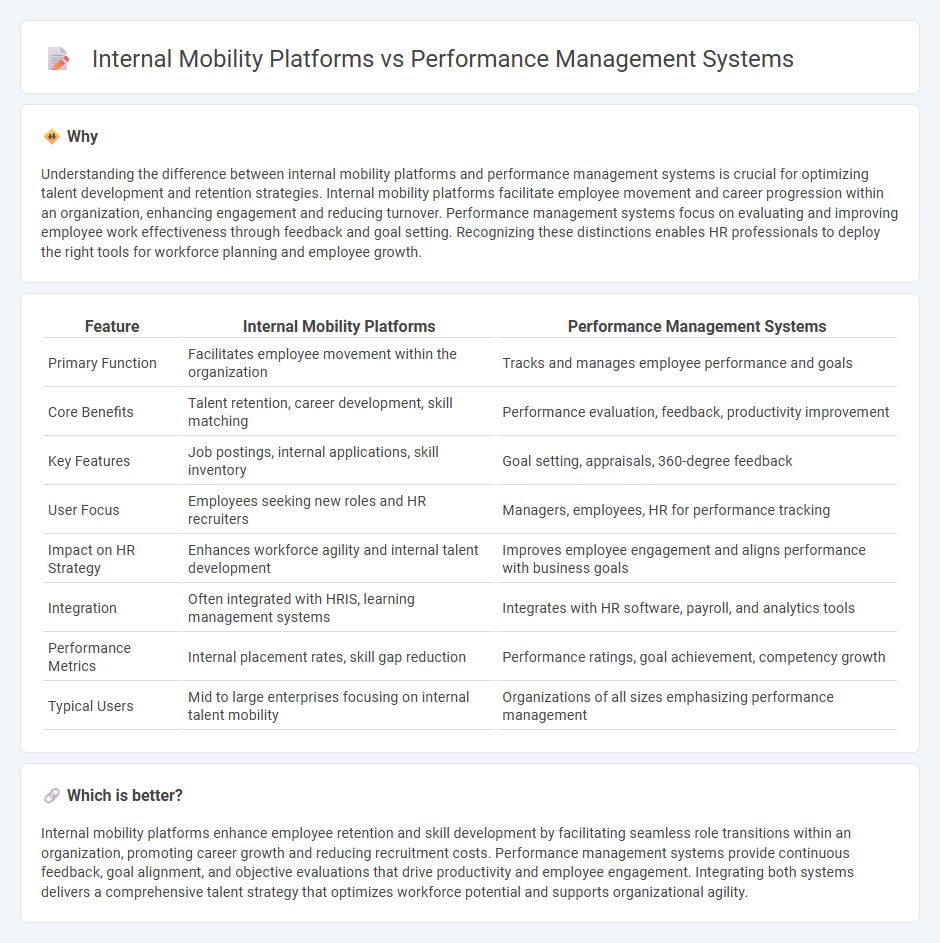
Internal mobility platforms enable organizations to strategically match employees to new roles based on skills, career goals, and organizational needs, enhancing talent retention and workforce agility. Performance management systems focus on evaluating, developing, and optimizing employee performance through regular feedback, goal-setting, and appraisals, driving productivity and alignment with business objectives. Discover how integrating these solutions can transform talent management and fuel organizational growth.
Why it is important
Understanding the difference between internal mobility platforms and performance management systems is crucial for optimizing talent development and retention strategies. Internal mobility platforms facilitate employee movement and career progression within an organization, enhancing engagement and reducing turnover. Performance management systems focus on evaluating and improving employee work effectiveness through feedback and goal setting. Recognizing these distinctions enables HR professionals to deploy the right tools for workforce planning and employee growth.
Comparison Table
| Feature | Internal Mobility Platforms | Performance Management Systems |
|---|---|---|
| Primary Function | Facilitates employee movement within the organization | Tracks and manages employee performance and goals |
| Core Benefits | Talent retention, career development, skill matching | Performance evaluation, feedback, productivity improvement |
| Key Features | Job postings, internal applications, skill inventory | Goal setting, appraisals, 360-degree feedback |
| User Focus | Employees seeking new roles and HR recruiters | Managers, employees, HR for performance tracking |
| Impact on HR Strategy | Enhances workforce agility and internal talent development | Improves employee engagement and aligns performance with business goals |
| Integration | Often integrated with HRIS, learning management systems | Integrates with HR software, payroll, and analytics tools |
| Performance Metrics | Internal placement rates, skill gap reduction | Performance ratings, goal achievement, competency growth |
| Typical Users | Mid to large enterprises focusing on internal talent mobility | Organizations of all sizes emphasizing performance management |
Which is better?
Internal mobility platforms enhance employee retention and skill development by facilitating seamless role transitions within an organization, promoting career growth and reducing recruitment costs. Performance management systems provide continuous feedback, goal alignment, and objective evaluations that drive productivity and employee engagement. Integrating both systems delivers a comprehensive talent strategy that optimizes workforce potential and supports organizational agility.
Connection
Internal mobility platforms and performance management systems are interconnected through their shared goal of optimizing talent development and workforce agility. Performance management systems provide valuable data on employee skills, achievements, and growth potential, which internal mobility platforms use to match employees with suitable internal job opportunities. This integration enhances employee retention, career progression, and organizational productivity by enabling data-driven talent mobility decisions.
Key Terms
**Performance Management Systems:**
Performance management systems streamline employee evaluations by integrating continuous feedback, goal setting, and performance analytics to enhance productivity and align individual objectives with company strategies. These platforms leverage data-driven insights to identify skill gaps, track progress, and support leadership decisions for talent development. Discover how implementing an advanced performance management system can transform workforce effectiveness and retention.
Goal Setting
Performance management systems prioritize goal setting by enabling clear, measurable objectives aligned with organizational strategy, enhancing employee accountability and progress tracking. Internal mobility platforms incorporate goal setting to support career development paths, helping employees identify skills gaps and align their aspirations with available roles. Explore how integrating these systems can optimize both performance outcomes and mobility opportunities.
Feedback
Performance management systems primarily concentrate on delivering structured, continuous feedback to enhance employee productivity, aligning individual goals with organizational objectives. Internal mobility platforms facilitate feedback by identifying skill gaps and providing insights for career development, enabling employees to make informed decisions about internal job opportunities. Explore our detailed comparison to understand how feedback functions optimize talent growth in both systems.
Source and External Links
14 Best Performance Management Systems of 2025 - This article lists the top performance management systems, such as Workday and Lattice, highlighting their features and benefits for managing employee performance.
30 Best Performance Management Software & Tools of 2025 - This page provides a comprehensive list of performance management software, including tools for goal setting, reviews, and continuous feedback, to help organizations streamline evaluations and development.
PerformYard - PerformYard offers flexible performance management software that facilitates employee reviews, goal tracking, and feedback through various review types and AI-assisted tools.
 dowidth.com
dowidth.com